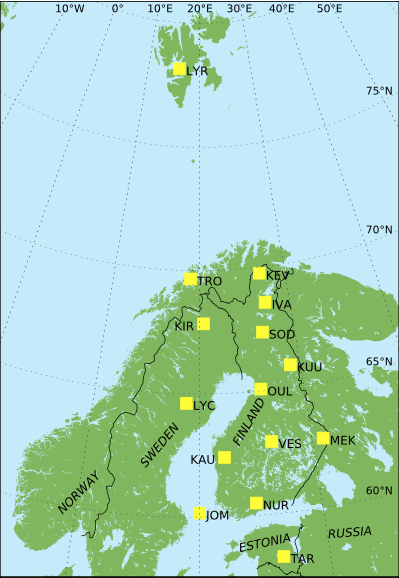Sodankylä Geophysical Observatory |
Ionospheric tomography

SGO Ionospheric Tomography Chain has been in operation since November 2002. Until 2017 the five INVERS built receivers of SGO operated in Kilpisjärvi Feb 2004-2013(originally at Tröso (2002- Feb 2004), Kokkola (Finland) 2002-2015, Luleå 2002-2014 and Kiruna (Sweden), 2002-2017. During the year 2017 old SGO receivers were replaced by RFsTomo1 receivers and partly relocated. Campaign based ionospheric tomography measurements combined with the Finnish EISCAT Campaigns have been done before start of regular operation 2002.
FMI has built up TomoScand receiver network based on USRP radios. SGO receivers were upgraded in RLab project funded by European Union's European Regional Development Fund. First of the ten new receivers produced by (RLab project / RF-Shamaanit Oy) was installed to Kiruna in 1 June 2017 and alltogether 9 receivers were in operation in autumn 2017. More about new receivers, see our poster in 14th European SpaceWeather Week: New Space Weather Instrumentation in Support of EISCAT_3D Since late 2017 two receiver networks (SGO an FMI) form joint FMI-SGO TomoScand network.
Contacts:
PI of Joint FMI-SGO TomoScand network: Johannes Norberg, FMI
SGO's RFsTomo1 receivers: Mikko Orispää, SGO
SGO's old receiver chain: Tero Raita, SGO
FMI's TomoScand receivers: Johannes Norberg, FMI
STATUS (10.02.2021):
The beacon status (150/400MHz) on the polar area is weak. Only DMSP-15 and e-POP CASSIOPE beacons are available for the receiver network. Nine SGO's RFsTomo1 receiver stations are in operation: KIR, IVA, SOD, KUU, OUL, VES, KAU, NUR and JOM in collaboration with FMI TomoScand receivers.



